The Division of Child and Family Services (DCFS) is "the child, youth, and family services authority of the state." Its primary purpose is to provide child welfare services. The division shall also, "... when possible and appropriate, provide preventive services and family preservation services..." Additionally, the division shall "provide domestic violence services in accordance with federal law." By statute, DCFS is to provide child abuse prevention services, child protective services, shelter care, foster care, residential care, adoption assistance, health care for children in state custody, family preservation, protective supervision, and domestic violence preventive services. DCFS is a state-administered agency with headquarters in Salt Lake City and five regional administrative centers.
Additional information regarding the Division of Child and Family Services can be found on its official website found at: Utah Division of Child and Family Services
The Division of Services for People with Disabilities' most recent annual report can be found at: DCFS Annual Report 2014
During the 2015 General Session, the Legislature appropriated for Fiscal Year 2016, $172,246,900 from all sources for Child and Family Services. This is a 2 percent increase from Fiscal Year 2015 revised estimated amounts from all sources. The total includes $115,577,600 from the General/Education Funds, an increase of 2.1 percent from revised Fiscal Year 2015 estimates.
In addition to statewide compensation and internal service fund cost increases, the following appropriation adjustments were made during the 2015 General Session:
Separate tables are shown under the tab labeled "Financials" in each COBI section. These tables provide information regarding: 1) funding sources (where the money comes from), 2) standardized state expenditure categories (where the money goes), and 3) agency sub-programs (when viewed at the line item level). For the most recent completed fiscal year, the following information represents the purposes for which the money was used:
DCFS operates six major programs. The following table shows direct costs of each of these six programs, including personnel, travel, current expense, and passthrough payments to providers. The administrative overhead for the state office and the MIS computer system were not allocated to the programs but are shown on the last line.
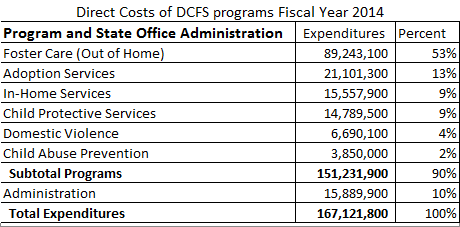
The six major programs operated by DCFS include:
- Out-of-Home (Foster Care) - housing, maintenance, and health care services for children who are removed from their homes and in DCFS custody. Includes payments for all levels of care from basic foster homes to residential facilities and institutions.
- Adoption Services - monthly or onetime subsidies paid to families who adopt a foster child.
- Child Protective Services - services provided by DCFS to investigate allegations of abuse, neglect, or dependency of children
- In-Home Services - services provided to children at risk of abuse, neglect, or dependency and families who are at risk of being separated by an out-of-home placement
- Domestic Violence - outreach and case management services provided to domestic violence victims and their dependent children through contracted family violence shelters and community services
- Child Abuse Prevention - preventative services through contracted providers and community-based organizations that help families resolve conflicts and behavioral or emotional concerns

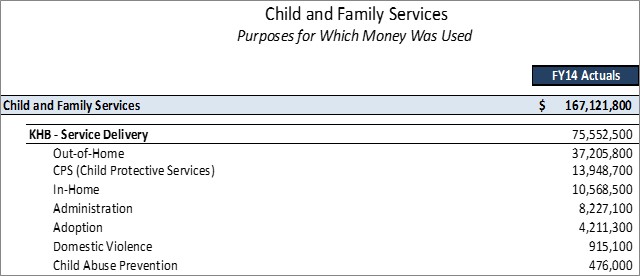


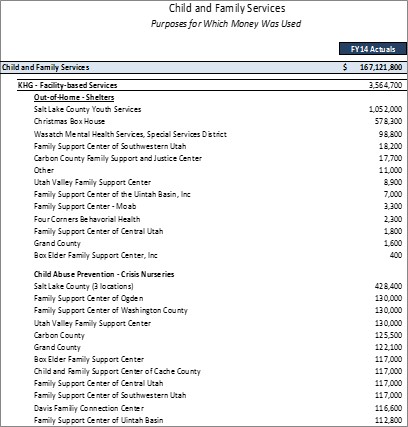
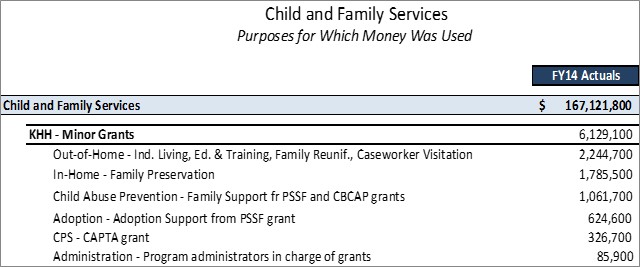


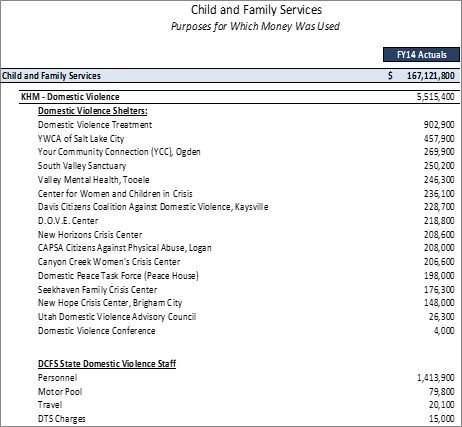
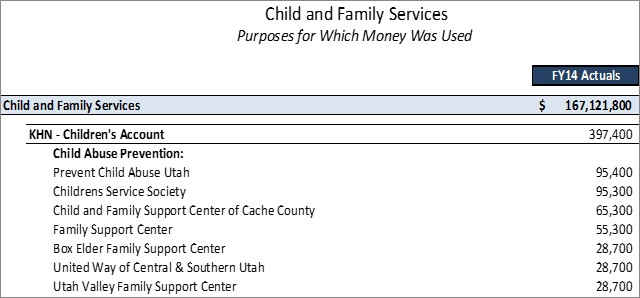
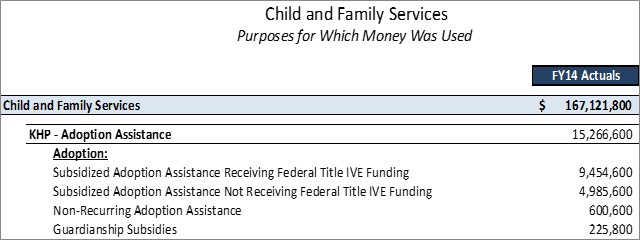
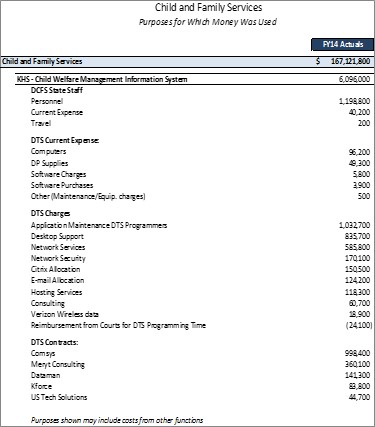
The following table shows FY 2014 expenditures by category provided through outside entities for the Division of Child and Family Services.
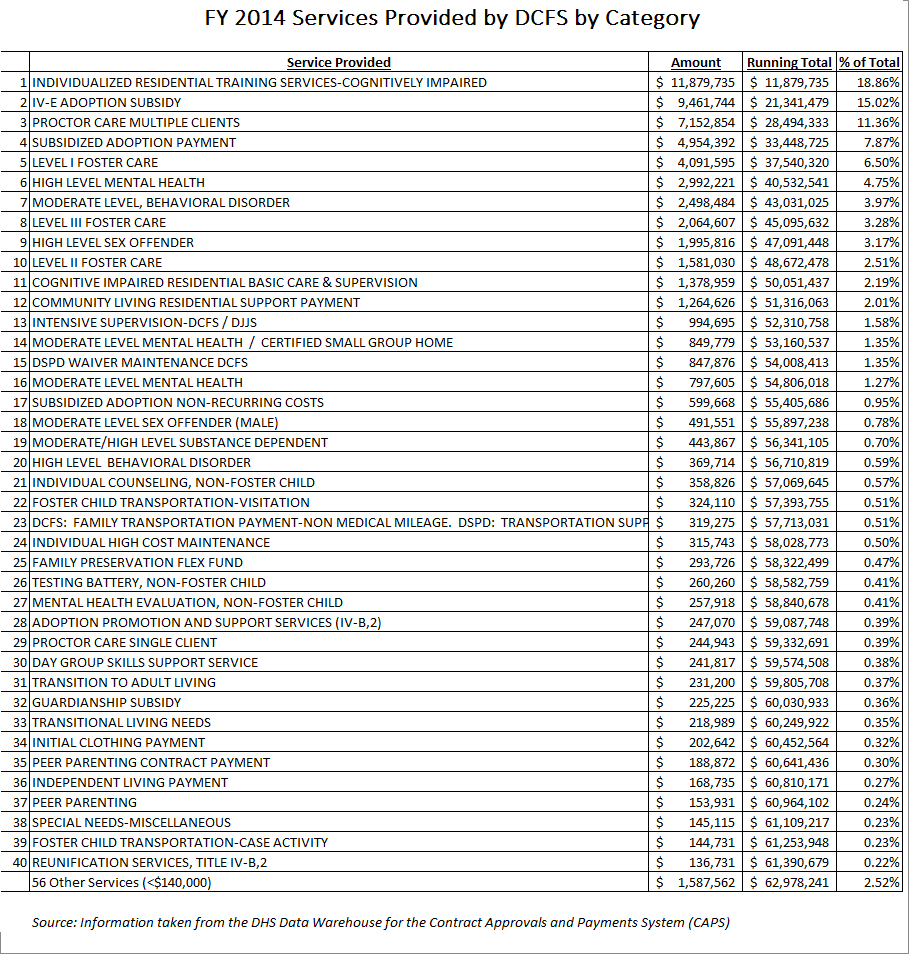
In FY 2014 there were 5,619 community providers delivering services on behalf of the Division of Child and Family Services. Of the 5,619, 40 providers delivered 51 percent of the total amount expended on these services as the following table shows.

Child and Family Services Processes and Procedures
DCFS SAFE Modernization Progress Report
Utah Code Title 62A, Chapter 4a authorizes and describes the programs of the Division of Child and Family Services:
- Part 1: Creation and duties of the division
- Part 2: Rights of parents and children, the state's interest and responsibilities, and details of the various child welfare programs
- Part 3: Child abuse and neglect prevention and treatment
- Part 4: Child abuse and neglect reporting requirements
- Part 5: Shelter services and services to runaways
- Part 6: Child placing agencies
- Part 7: Interstate Compact on Placement of Children
- Part 8: Process for the safe relinquishment of a newborn child
- Part 9: The division's child adoption assistance plan
- Part 10: Management Information System and Licensing Information System
Utah Code Title 78A, Chapter 6, Juvenile Court Act of 1996, has several sections that apply to the Division of Child and Family Services:
- Part 3: Abuse, Neglect and Dependency Proceedings
- Part 4: Minors in custody on grounds other than abuse or neglect
- Part 5: Termination of Parental Rights Act
- Part 9: Guardian Ad Litem program
In addition to state law, many functions provided by DCFS have provisions detailed in federal law. Those federal law references, where available, follow:
42 U.S.C. 621 et. seq. (Social Security Act Title IV-B)
- Part 1: General child welfare services
- Part 2: Promoting safe and stable families
42 U.S.C. 670 et. seq. (Social Security Act Title IV-E)
- Foster care maintenance
- Adoption assistance
- Foster care independence program
- Education and training voucher program
42 U.S.C. 5101 et. seq. (Child Abuse Prevention and Treatment Act)
- Basic state grant
- Community-based child abuse prevention
There are two restricted accounts that are used in connection with the Division of Child and Family Services: 1) Victims of Domestic Violence Services Account and 2) Children's Account. A five year history of each account is shown here:
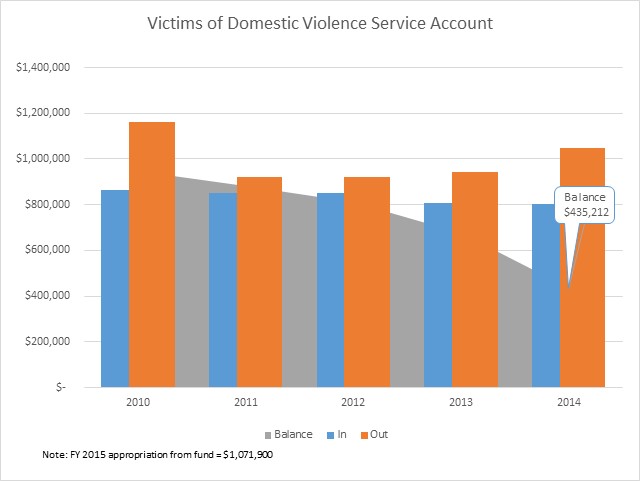
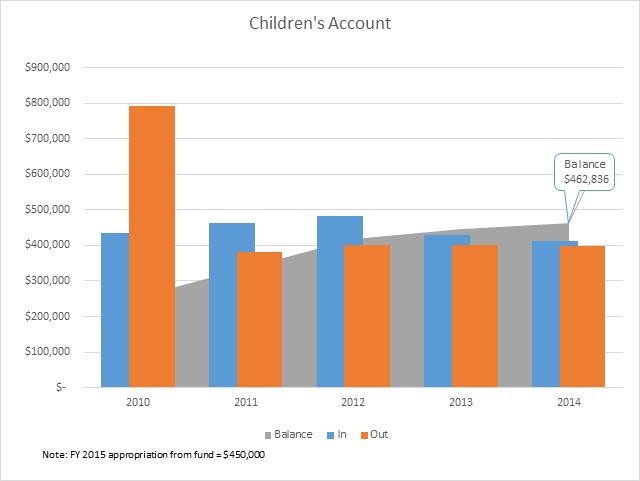
For analysis of current budget requests and discussion of issues related to this budget click here.
COBI contains unaudited data as presented to the Legislature by state agencies at the time of publication. For audited financial data see the State of Utah's Comprehensive Annual Financial Reports.